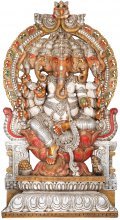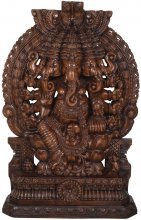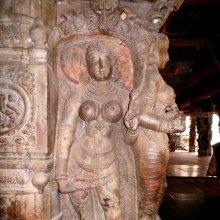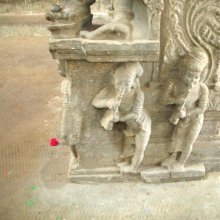South Indian temple: 1 definition
Introduction:
South Indian temple means something in Hinduism, Sanskrit. If you want to know the exact meaning, history, etymology or English translation of this term then check out the descriptions on this page. Add your comment or reference to a book if you want to contribute to this summary article.
Images (photo gallery)
In Hinduism
Natyashastra (theatrics and dramaturgy)
Source: Shodhganga: The significance of the mūla-beras (natya)The South Indian temples, with their characteristic tiered vimāna shrines, major and minor, their axial and peripheral maṇḍapa adjuncts, which are flat roofed halls, and the towering gopura entrances, form a distinct class by themselves as distinguished from the North Indian temples.

Natyashastra (नाट्यशास्त्र, nāṭyaśāstra) refers to both the ancient Indian tradition (shastra) of performing arts, (natya—theatrics, drama, dance, music), as well as the name of a Sanskrit work dealing with these subjects. It also teaches the rules for composing Dramatic plays (nataka), construction and performance of Theater, and Poetic works (kavya).
See also (Relevant definitions)
Partial matches: South, Indian, Temple.
Full-text: Gopura, Antaralamantapam, Shikhara, Vimana, Amalaka, Temple worship, Kalasha, Prasada.
Relevant text
Search found 18 books and stories containing South Indian temple; (plurals include: South Indian temples). You can also click to the full overview containing English textual excerpts. Below are direct links for the most relevant articles:
Vastu-shastra (5): Temple Architecture (by D. N. Shukla)
Bhaumika Vimānas (Temples of South India, Decan and Greater India) < [Chapter 12 - History of Hindu Temples (Prāsādas and Vimānas)]
Expiatory Rites in Keralite Tantra (by T. S. Syamkumar)
1.8 (b). Expiatory Rites in Prāyaścittasamuccaya < [Chapter 2 - Expiatory Rites in Āgamic Literature]
2. Mistakes in Ritual < [Chapter 1 - Expiatory Rites: Concept and Evolution]
Kashyapa Shilpa-shastra (study) (by K. Vidyuta)
3. Conclusion (Gopuras) < [Chapter 6 - Conclusion]
6. Further Scope for Research < [Chapter 6 - Conclusion]
1. Conclusion (Prākāras) < [Chapter 6 - Conclusion]
Parama Samhita (English translation) (by Krishnaswami Aiyangar)
Pāñcarātra worship common in South Indian temples < [Introduction]
Gati in Theory and Practice (by Dr. Sujatha Mohan)
Temples as seat of learning < [Chapter 4 - Practice of Gati]
Dance movements found in sculptures < [Chapter 4 - Practice of Gati]
Temples of Munnur (Historical Study) (by R. Muthuraman)
Images of the Saptamatrikas < [Chapter 5]
Pallava Period < [Chapter 1]
Munnur temple Property < [Chapter 3]




